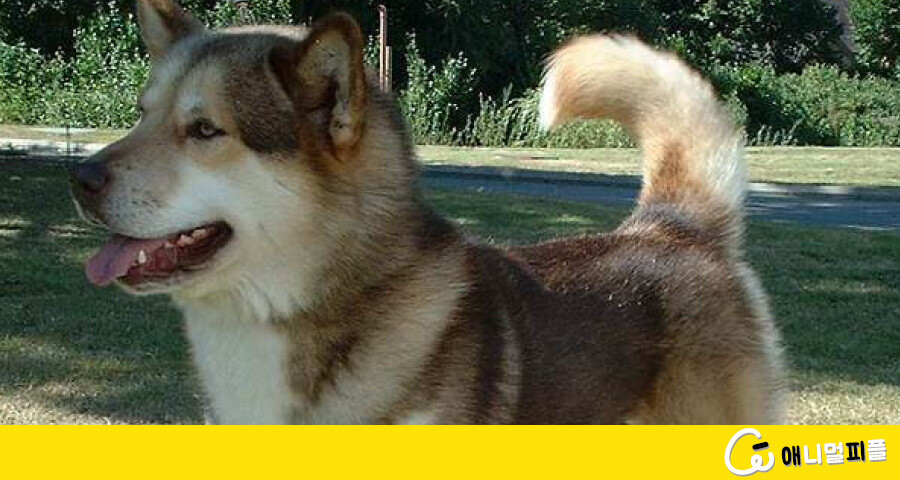[애니멀피플]
45% of prey lean meat remains… I would have fed the wolf cubs I brought

The wolf (left) has evolved into a number of breeds of dogs, including Chihuahuas (right), making it the most successful predator on Earth numerically. However, when, where and how domestication took place is still debated. Provided by Wikimedia Commons
Dogs were the earliest domesticated of all animals. However, when and where and how wolves became domestic animals is a long debate. The oldest Paleolithic remains of dog skeletons were 14,200 years ago. Genetic analysis studies estimate dog domestication to be between 27,000 and 40,000 years ago. At least 15,000 years ago, up to about 40,000 years ago, dogs were separated from the ancestors of wolves. Considering the location where the dog remains were excavated, it can be said that dogs began to become domestic animals in the northern part of the Eurasian continent at the height of the last Ice Age.

Greenland dog, one of the oldest breeds of dogs. Domestication of dogs began in northern Eurasia during the Ice Age. Provided by Wikimedia Commons
Why did the wolf become a dog? Two hypotheses are influential. The Hunting Companion Hypothesis explains that humans use wolves’ hunting abilities, and wolves have prospered by taking people as heads (▶Why did the wolf decide to be a dog). However, this hypothesis does not explain how untamed wolves came to hunt with humans that require high communication. The cleaner hypothesis believes that dogs gradually became closer to humans by eating food scraps that people had thrown away. It is argued that humans did not turn wolves into dogs, but that wolves chose themselves to become dogs. This hypothesis is supported by the fact that dogs have starch-degrading enzymes that were not found in wolves. In a paper published in the scientific journal Scientific Report on the 8th, Maria Latinen, Ph. They argued that domestication of dogs had begun.

Vegetation and dog ruins (red dot) at the peak of the last Ice Age. Most of them are steppe-tundra regions with harsh winter weather. Courtesy of Maria Latinen et al. (2020)
Researchers noted that northern Eurasia, where dog remains were found, was a grassland-tundra region with very harsh climates during the peak of the last Ice Age. The vegetable food obtained in the short summer fell quickly in the long winter and had to live solely as a hunted hoofed animal. The problem is that the hunter-gatherers and wolves here were similar hunters who hunted large herbivores such as horses, reindeer and deer through persistent pursuit. The two are the same target of hunting, and they are rivals who can kill and kill each other, so how could it be domesticated? “The evolutionary difference between humans and wolves has allowed them to beat the competition,” the researchers said. People, who are predators from herbivores, have limitations in breaking down protein, so they cannot live by eating only meat, but must consume fat and carbohydrates together. On the other hand, wolves, which have evolved into predators early on, can live for months and eat only lean meat.

A wolf in Yellowstone National Park, USA, is hunting a bison. Wolves and hunter-gatherers have similar hunting methods to prey. Duc Smith, Yellowstone National Park Management Office, courtesy of Wikimedia Commons
How did the Ice Age winter hunter-gatherers live, who only had meat to eat? Researchers said, “A person can only cover about 20% of calories with protein, so if you consume only excess lean meat, you can get fatal protein poisoning.” It would have been slaughtered.” Protein addiction is a side effect of eating too much protein without fat or carbohydrates, and can be fatal due to excessive amounts of ammonia, urea, and amino acids in the blood. It occurs when more than 35% of the total calories consumed is covered by protein. However, as a result of analyzing the calories of prey living in this climate zone, it was found that 45% of protein calories exceeded the limit that humans can consume. Researchers claim that “the wolves were given the remaining lean meat, and this may have been the beginning of domestication.” For example, the hunter-gatherer began to bring orphaned wolf cubs as pets while feeding the excess lean meat.

Wolves are the only animals domesticated during hunting and hunting before humans settled for farming. The starting point may be a lost wolf cub brought as a pet and fed the excess meat. Jim Pico, courtesy of Wikimedia Commons
Domestication is known to go through a very complex process several times. Dogs often crossed with wild wolves. Researchers said, “For dogs and hunter-gatherers who did not need to compete for food, small benefits such as help in hunting and defense from predators are helpful for both.” It is likely to have happened.” Cited Papers: Scientific Reports, DOI: 10.1038/s41598-020-78214-4 By Cho Hong-seop, staff reporter [email protected]
